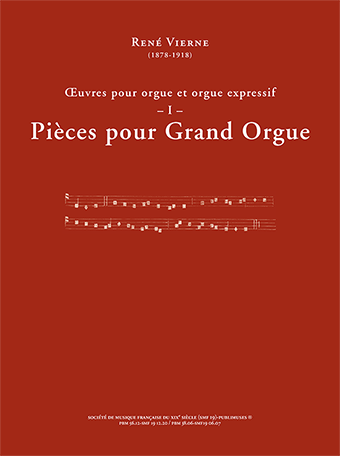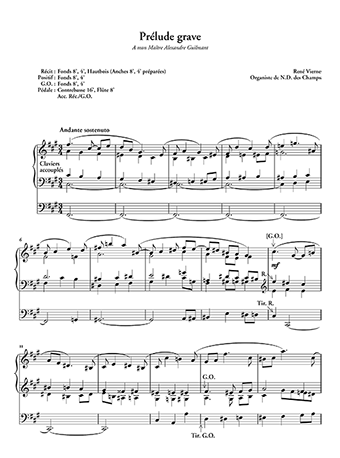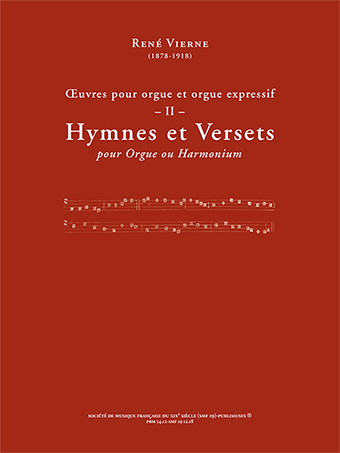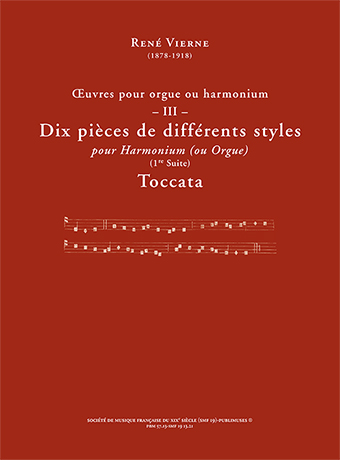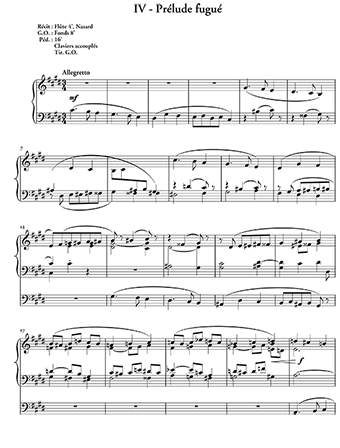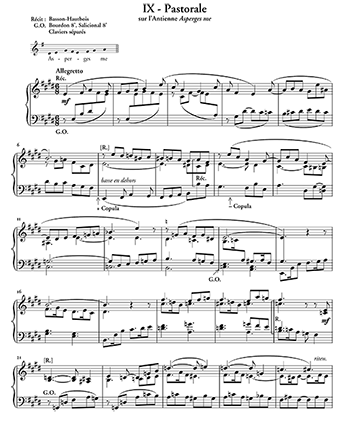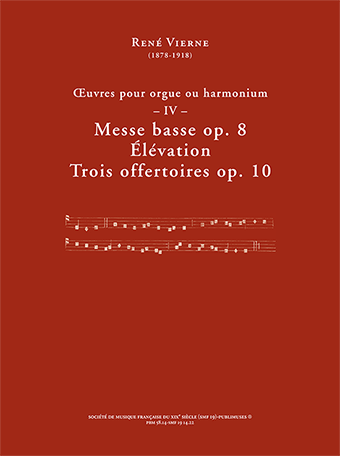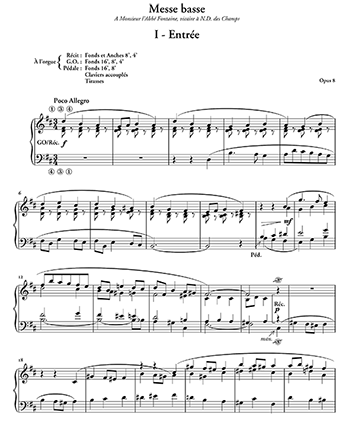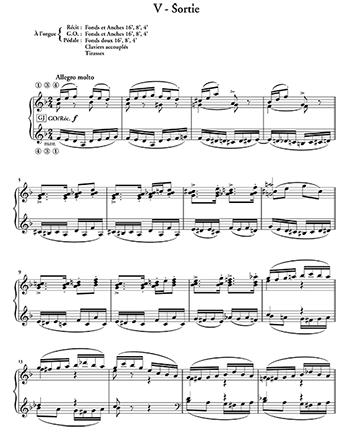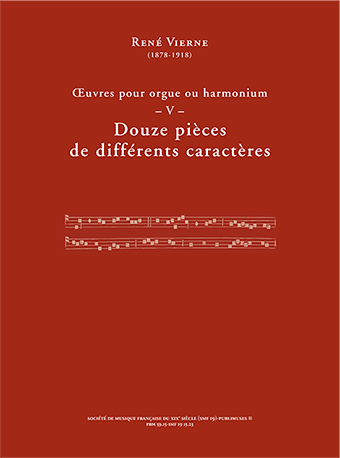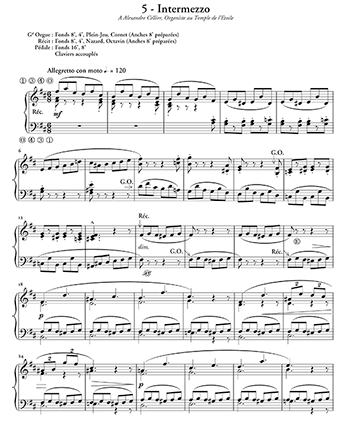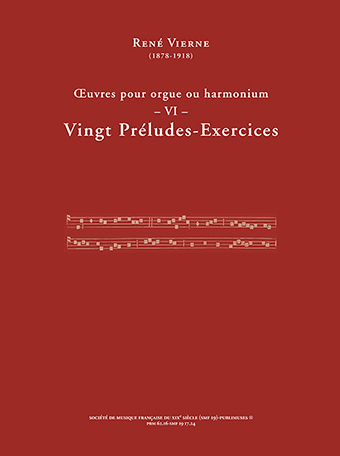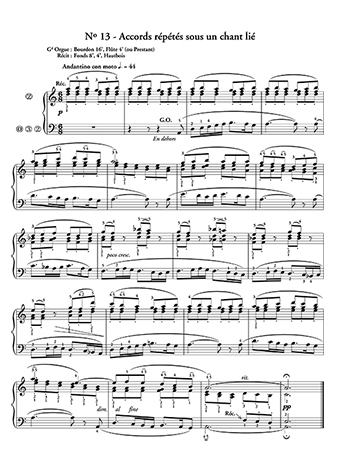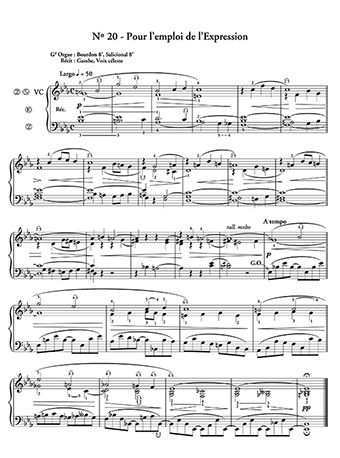Composer's Catalogue
René VIERNE
(1878-1918)
Vierne
Œuvres pour orgue et orgue expressif
Volume I
Pièces pour Grand OrgueRef. PBM 56.12-SMF19 12.20/PBM 38.06-SMF19 06.07 (2e édition)
↓Vierne
Œuvres pour orgue et orgue expressif
Volume II
Hymnes et Versets pour Orgue ou HarmoniumRef. PBM 54.12-SMF19 12.18
↓Vierne
Œuvres pour orgue et orgue expressif
Volume III
Dix pièces de différents styles pour Harmonium (ou Orgue)
ToccataRef. PBM 57.13-SMF18 13.21
↓Vierne
Œuvres pour orgue et orgue expressif
Volume IV
Messe basse op. 8
Élévation
Trois offertoires op. 10Ref. PBM 58.14-SMF18 14.22
↓Vierne
Œuvres pour orgue et orgue expressif
Volume V
Douze pièces de différents caractèresRef. PBM 59.15-SMF19 15.23
↓Vierne
Œuvres pour orgue et orgue expressif
Volume VI
Vingt Préludes-ExercicesRef. PBM 62.16-SMF19 17.24
↓In progress
↓
Works for Organ and orgue expressif
René Vierne
Œuvres pour orgue et orgue expressif
Volume I
Pièces pour Grand Orgue
Ref. PBM 56.12-SMF19 12.20/PBM 38.06-SMF19 06.07 • 2nd edition
Technical info
A volume 310 x 225 (portrait format). 48-page. Preface Brigitte De Leersnyder. Presentation and Editorial notes in French, English.
Contents
Méditation, Prélude grave, Canzona, Intermezzo and the Sept Pièces pour les Vêpres du commun des Saints (the full text of the antiphons has been reproduced, providing the performer with an opportunity of observing R. Vierne’s setting of them), Gavotte after the 2nd Sonata for the violin of J.S. Bach.
Summary
This volume includes the full catalogue of the works by R. Vierne, the youngest brother of the organist of Notre-Dame, Louis Vierne.
René Vierne
Œuvres pour orgue et orgue expressif
Volume II
Hymnes et Versets
pour Orgue ou Harmonium
Ref. PBM 54.12-SMF19 12.18
Technical info
A fascicle 230 x 310 (portrait format). 32-page. Edition N. Bertrand. Presentation in French and English.
Contents
Cinq improvisations pouvant servir de Ier Versets de Magnificat ou IIe Interludes de psaumes : N° 1 Allegro maestoso; 2e Allegretto; 3° Adagio; 4e Andanti; 5e Vivace.
Interludes de Procession pour l'Hymne Pánge língua : N° 1 Pánge lingua gloriósi; N° 2 Córporis mystérium; N° 3 Sanguinísque pretiósi; N° 4 Frúctus véntris generósi Rex effúdit géntium.
Interludes pour l'Hymne Ave Máris stélla : N° 1 Ave Máris stélla; N° 2 Lento sostenuto; N° 3 Maestoso e marcato.
Les Vêpres de Pâques : N° 1 Petit carillon; N° 2 1er Interlude; N° 3 2e Interlude; N° 4 Sortie douce.
Summary
Pánge língua • This hymn was written by St Thomas Aquinas (1225-1274) for the Feast of the Blessed Sacrament. It is sung during the Vespers at the Feast of Corpus Christi. It is also sung on Maundy Thursday, during the procession from the church to the place where the Blessed Sacrament is kept until Good Friday. The last two stanzas, called separately Tántum Ergo, are sung at Benediction of the Blessed Sacrament. The hymn expresses the doctrine of transubstantiation, in which, according to the Roman Catholic faith, the bread and wine are changed into the Body and Blood of Christ.
Ave máris stélla • Ave máris stélla is a popular liturgical hymn of unknown origin. It can be dated back to at least the 9th century. Made of seven stropes, it is assigned to Vespers in the Common Office as well as for Feasts of the Blessed Virgin. The first strope of an unrhymed, accentual rythm, is declaimed on one's knees.
René Vierne
Œuvres pour orgue et orgue expressif
Volume III
Dix pièces de différents styles
pour Harmonium (ou Orgue)
(1ère Suite)
Toccata
Ref. PBM 57.13-SMF18 13.21
Technical info
A fascicle 230 x 310 (portrait format). 40-page. Edition N. Bertrand. Presentation in French and English.
Contents
Dix pièces de différents styles: No. 1 Entrée, C major; No. 2 Prélude funèbre, C minor; No. 3 Prière, D b majeur; No. 4 Prélude fugué, C # mineur; No. 4, Prélude fugué, C # mineur (other version); No. 5 Sortie, D major; No. 6 Postlude, D minor; No. 7 Caprice, E b major; No. 8 Absoute, E b minor; No. 9 Pastorale on the Anthem Asperges me, E major; No. 10 Canzona, E minor.
Toccata, G minor.
René Vierne
Œuvres pour orgue et orgue expressif
Volume IV
Messe basse op. 8
Élévation
Trois offertoires op. 10
Ref. PBM 58.14-SMF18 14.22
Technical info
A fascicle 230 x 310 (portrait format). 36-page. Edition N. Bertrand. Presentation in French and English.
Contents
Messe basse op. 8: No. 1 Entrée, D; No. 2 Offertoire, G major; No. 3 élévation, E minor; No. 4 Communion, A major; No. 4, Sortie, B minor.
Élévation, B b major.
Trois offertoires op. 10: No. 1 Offertoire sur un thème breton, B; No. 2 Offertoire sur un thème original, D major; No. 3 Offertoire sur la prose Inviolata, B b major.
Summary
In the absence of any manuscript, it can be assumed that René Vierne's Messe basse, published in 1914 — one year after the one authored by his brother Louis — was written around 1902 (while R. Vierne was holding the chancel organ) or, more probably, between 1904 and 1914, the period when he was in charge of the main organ of Notre-Dame des Champs.
René Vierne
Œuvres pour orgue et orgue expressif
Volume V
Douze pièces de différents caractères
Ref. PBM 59.15-SMF19 15.23
Technical info
A fascicle 230 x 310 (portrait format). 48-page. Edition N. Bertrand. Presentation in French and English.
Contents
No. 1. Pastorale in F # major — No. 2. Prélude pour une Messe basse in C minor — No. 3. Offertoire sur le Kyrie de la Messe du 6ème Ton (H. Du Mont) in F major — No. 4. Prière in C # minor — No. 5. Intermezzo in D major — No. 6. Prélude en forme de canon in B b major — No. 7. Noël in A — No. 8. Offertoire pour les fêtes de la Ste Vierge in D major — No. 9. Cantabile in C major — No. 10. Absoute in E — No. 11. Épithalame in E b major — No. 12. Marche de procession in D major.
Summary
The Douze pièces de différents caractères (Twelve parts of various characters) are the third part of the Méthode pour orgue-harmonium (Method for organ-harmonium), published in 1913 by Alphonse Leduc and now unavailable.
In the Foreword, René Vierne writes: “[...] We recommend the theory of J.B. Lemmens, the author of the famous ‘Ecole d'Orgue’ (Organ School) [...]. The 12 Pieces following the theoretical section can be performed on the Great Organ. Organists will find in the registration specified there the general indication of the colours applicable to each piece; we leave it up to their own taste to choose the detail when using a 3- or 4-manuals instrument. Those familiar with the pedal keyboard may use it in some of the pieces to reinforce the bass part. We have not indicated specifically the passages potentially involving the pedal keyboard; the performer shall apply it as needed. R.V.”.
René Vierne
Œuvres pour orgue et orgue expressif
Volume VI
Vingt Préludes-Exercices
Ref. PBM 62.16-SMF19 17.24
Technical info
A fascicle 230 x 310 (portrait format). 44-page. Edition N. Bertrand. Presentation in French and English.
Contents
No. 1. Single substitution, A major — No. 2. Single substitution, E b major — No. 3. Double substitution, E b major — No. 4. Double and triple substitutions, C major — No. 5. Single glide, G minor — No. 6. Single glide and reversed fingering, G major — No. 9. Link between octaves by thumb glide, F major — No. 10. Reversed fingering, A minor — No. 11. Articulations of chords to half of their duration, C # minor — No. 12. Articulated chords, E major — No. 13. Repeated chords under a singing legato line, A minor — No. 14. Linked common notes - Articulation of holded notes in melodic sections, C major — No. 15. On staccato study (right hand), D major — No. 16. On staccato study (left hand), D minor — No. 17. On melodic Ornaments, D major — No. 18. On Articulation, F major — No. 19. On Expression use, D major — No. 20. On Expression use, E b major.
Summary
The Vingt Préludes-Exercices are the first part of the Méthode pour orgue-harmonium (Method for organ-harmonium), published in 1913 by Alphonse Leduc and now unavailable.
In the foreword of the Method, René Vierne writes: “This method is designed for people who already have some practice of the piano [...] and can be used without any suppression or addition for the study of the manual keyboards of the the pipe organ.”
In Progress
René Vierne
Deux motets pour chœur à 4 voix mixtes et orgue
Reviews
René Vierne
Œuvres pour orgue et orgue expressif
Volume I
Pièces pour Grand Orgue
Ref. PBM 38.06-SMF19 06.07
“René Vierne’s style is clearly influenced by the music of his eldest brother and also that of César Franck but this modest collection provides an excellent resource for liturgical use.”
(S.S., The Organ, No. 337 Aug.-Oct. 2006)
“This volume is the first of a projected edition of the organ works of Louis Vierne’s youngest brother. […] Volume 1 comprises four secular pieces and seven liturgical pieces. All the music here was published in separate editions and the editor has been at pains to present the secular pieces in chronological order as far as possible. The secular pieces are all characterised by the shifting, restless enharmonic harmonies, chromaticisms and sequences beloved of the post-César Franck school. […] The Vesper antiphons are beautifuly crafted miniatures showing René Vierne’s control of contrapuntal techniques. The edition includes the complete texte of each antiphon from which the composer takes his inspiration. He produces music of great charm and character with hardly an accidental in sight. The volume is very well produced with extensives notes on the composer and a catalogue of his music. One awaits subsequent volumes in the series with great interest.”
(Alan Spredding, Organists’ Review, August 2006)

